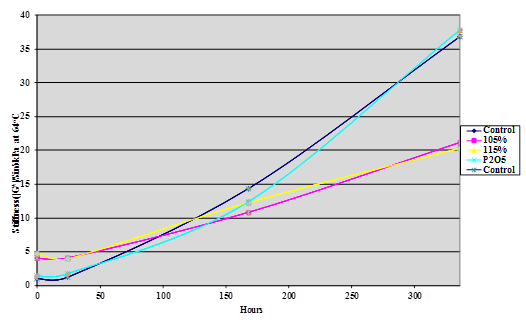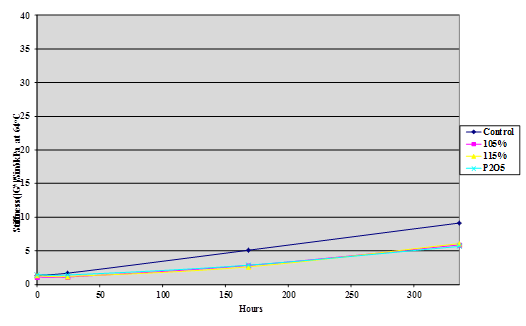U.S. Department of Transportation
Federal Highway Administration
1200 New Jersey Avenue, SE
Washington, DC 20590
202-366-4000
Federal Highway Administration Research and Technology
Coordinating, Developing, and Delivering Highway Transportation Innovations
| REPORT |
| This report is an archived publication and may contain dated technical, contact, and link information |
|
| Publication Number: FHWA-HRT-14-086 Date: November 2014 |
Publication Number: FHWA-HRT-14-086 Date: November 2014 |
DOES PHOSPHORIC ACID CATALYZE ASPHALT OXIDATION IN HOT MIX ASPHALT BINDERS?
Phosphoric acid is used as a blowing catalyst in producing asphalt for roofing; consequently, fears have been expressed that its use as a binder modifier will cause premature aging of paving asphalts. To test this concern, samples were modified with 105- and 115-percent phosphoric acid and aged at 100 °C in the PAV under air pressure. Because phosphorus pentoxide has been used as a blowing catalyst, it was included in the study.
Samples were stored in open ¼-pint cans. The level of acid used was 1 percent (calculated as 100-percent acid). The stiffness was measured as |G*|/Sinδ at 64 °C. The results are shown in figure 29 to figure 32 , and the numerical data are shown in the appendix in table 36 through table 39 .
To determine whether any stiffness change was due to oxidation or simple the result of exposure to 100 °C temperature for 300 hours, the tests were repeated under nitrogen pressure instead of air. Figure 33 to figure 36 show the data graphically; the numerical results are in table 40 through table 43 .

Figure 29. Chart. PAV aging of asphalt AAD-1 modified with 1-percent phosphoric acid at 100 °C under air.

Figure 30. Chart. PAV aging of asphalt AAK-1 modified with 1-percent phosphoric acid at 100 °C under air.

Figure 31. Chart. PAV aging of asphalt AAM-1 modified with 1-percent phosphoric acid at 100 °C under air.

Figure 32. Chart. PAV aging of asphalt ABM-1 modified with 1-percent phosphoric acid at 100 °C under air.

Figure 33. Chart. PAV aging of asphalt AAD-1 modified with 1-percent phosphoric acid 100 °C under nitrogen.

Figure 34. Chart. PAV aging of asphalt AAK-1 modified with 1-percent phosphoric acid at 100 °C under nitrogen.

Figure 35. Chart. PAV aging of asphalt AAM-1 modified with 1-percent phosphoric acid at 100 °C under nitrogen.

Figure 36. Chart. PAV aging of asphalt ABM-1 modified with 1-percent phosphoric acid at 100 °C under nitrogen.